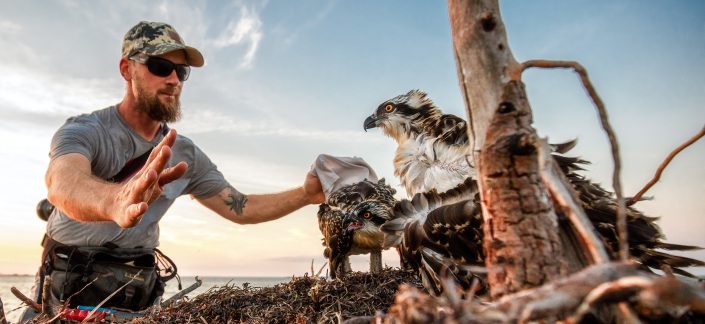NJ’s Osprey Population Continues Upward Trend
Results from the 2016 nesting season show very positive results. Statewide census planned for this year.
by Ben Wurst, Habitat Program Manager

New Jersey’s ospreys continue to defy my expectations. Since being tasked with coordinating the NJ Fish & Wildlife’s Osprey Project, I have witnessed the population grow from around 400 nesting pairs to an estimated 600. That’s a 30% increase in the overall state population. In addition, the productivity rate (a measure of the health for the population) has remained at level consistent with an increasing population. The results from last year were positive throughout almost all major nesting colonies that were surveyed. I’ve never been more amazed by the shear resiliency and adaptability of a species.
To quickly sum up the report, a total of 515 active nests were recorded. Of those a total of 376 pairs produced 670 young for a productivity rate of 1.78 young/active (known-outcome) nest. A total of 361 young were banded; 62 of those with red “field readable” red bands on Barnegat Bay. A total of 42 new nests were found statewide. The Delaware Bay colony continues its trend of being more productive. This could indicate that prey is more plentiful and nest sites are more reliable than Atlantic coastal colonies. It could also indicate the die hard efforts of Citizens United to Protect the Maurice River, our partner who monitors and maintains osprey nests on the Maurice River. A more detailed study of prey species and their seasonal fluctuations could be done to compare the different regions of the state and the life cycle of the ospreys that nest there. No doubt our waterways are also the cleanest that they’ve ever been and ospreys are the quintessential bio-indicators of a healthy coastal ecosystems.
This year we are planning the first statewide census of nesting ospreys since 2013. We will be conducting the survey in the same fashion, where we will be conducting widespread surveys and asking the public to report activity at nests on www.Osprey-Watch.org. While the overall population growth rate has slowed, we estimate that the overall population will surpass 600 nesting pairs easily; however it will not be an easy feat. By relying on citizen scientists to help gather this important data, it is imperative for us to communicate our needs to the public. We’re hopeful that social media (including going “live” on Facebook and Twitter) will help us to spread the word quickly.
- Read the full 2016 New Jersey Osprey Project in New Jersey report
- Learn more about our Osprey Project
- Donate to support this project!
Discover more from Conserve Wildlife Foundation of NJ
Subscribe to get the latest posts sent to your email.